The Effects Of Human Activities On Local Climate And Weather Behavior
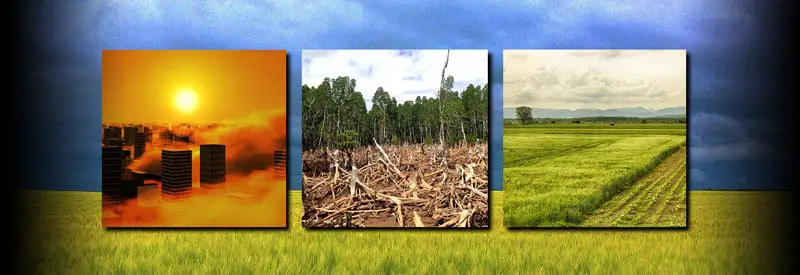
Climate and weather conditions not only occur on a regional or global scale but can often be confined to smaller localized areas. Some human activities have a significant impact on local weather patterns.
Local weather sometimes deviates from the regional weather forecast. It often happens due to natural local variables, like topography, nearby bodies of water, and specific weather conditions. (You may live in a valley near a lake with winds funneling through the ravine.)
Sometimes, though, large-scale human activities in an area can have a significant effect on local weather patterns and even have a permanent impact on its climate. It is these activities that will be the be focusing of this article.
- Deforestation
- Urban And Metropolitan Development
- 3Carbon Dioxide And Other Greenhouse Gases Emissions
- 4Agriculture
First, though, local weather can mean different things to different people, so it is essential to get a clear idea of what precisely it means when we talk about local weather.
What Is Local Weather
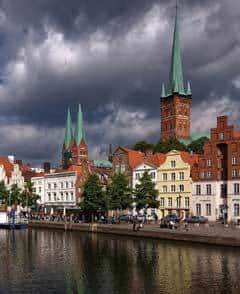
Local weather can be defined as the atmospheric conditions within a relatively small geographical area at any specific time. It includes weather variables such as temperature, wind, cloud formation, rainfall, and atmospheric pressure.
Such an area may include a city zone, a small town, or even a suburb.
The Human Activities That Influence Local Weather
Before we can examine the way in which human activities influence the weather, we first need to identify the specific actions that have a strong enough impact on the atmosphere to cause significant changes to weather conditions.
Each of the activities below causes changes to different aspects of the weather and with varying degrees of strength. Some human actions can combine to have a compound effect on the atmospheric conditions.
Below, you will find a list of the human activities identified to have some of the most significant impacts on local climate:
- Deforestation
- Urban And Metropolitan Development
- Carbon Dioxide And Other Greenhouse Gas Emissions
- Agriculture
These four actions are by now means the only human activities that influence the atmosphere and weather patterns. They are, however, the actions that have the most important and notable impact on local weather.
The Way In Which Specific Human Activities Influence Local Weather
Now that the most most significant human contributions to local weather change have been identified, one needs to take a closer look at each of these human activities to see the way in which they impact weather conditions.
1) Effects Of Deforestation
It is a well-known fact that for any rainfall to take place anywhere in the world, a substantial amount of moisture must be present in the air. The trees and plants in a forest provide a large portion of this essential moisture needed for condensation and cloud formation.
Although winds can take the humid air far away from the source of evaporation to cause precipitation in a completely different location, in many instances, rainfall takes place close to regions from which the humid air originated. The Tropical Rainforests are one such case.
The leaves from trees and plants provide a canopy to keep the soil moist, which is a major source of water for evaporation. Through a process called transpiration, the leaves of the vegetation also release additional moisture into the atmosphere.
What Is Deforestation?
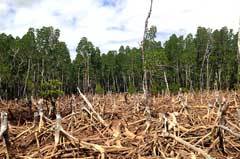
Deforestation is the permanent large-scale removal of vegetation, specifically trees and plants, to make space for urban development, road construction, or agricultural fields.
Across the world, especially in developing countries rich in vegetation, deforestation is taking place at an alarming rate. This practice destroys the ability of the land to provide the necessary moisture for precipitation to take place.
When deforestation takes place in a specific location and a large percentage of the local vegetation is permanently removed, it will have a profound impact on local rainfall. It may not be notable at first, but over time, the area will experience a drop in precipitation.
2) Urban And Metropolitan Development
The development of metropolitan and large urban areas inevitably means the construction of concrete buildings, pavements, and asphalt roads. These structures fundamentally change the atmospheric conditions of the atmosphere, especially influencing temperatures.
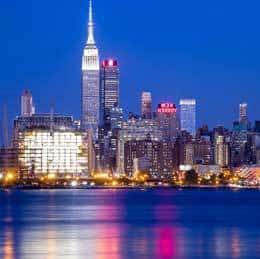
The dark colors of the buildings and roads allow the heat from the sun to be absorbed, and their structural make-up enables them to retain the heat for sustained periods. The result is a buildup of heat in and around cities and densely populated urban environments.
The heat produced by transportation, a lack of vegetation, as well as the release of carbon dioxide and other greenhouse gases into the atmosphere all contributes to higher temperatures throughout the city.
The presence of tall buildings also inhibits airflow through the area (a phenomenon called the Urban Canyon Effect), which further contributes to the heat buildup.
The combination of all the above-mentioned factors creates a microclimate known as the Urban Heat Island. To find out more, you can read the whole in-depth article about the Urban Heat Island, how it is formed, and its effects in this article.
3) Effects Of Carbon Dioxide And Other Greenhouse Gases
In the previous section, we already briefly touched on the issue of carbon dioxide and other greenhouse gases. In urban environments, emissions from cars, buses, and industries result in more concentrated levels of carbon dioxide in the air compared to rural regions.
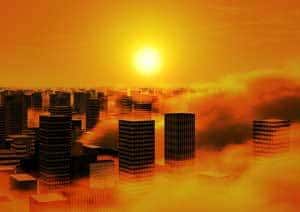
They are called greenhouse gases since they act as a real greenhouse, preventing heat from escaping and trapping it in the atmosphere below. Although these gases usually disperse and build up in the upper atmosphere, they can affect local conditions as well.
When the carbon dioxide gases hit a temperature inversion layer above a populated area, it traps the heat and gases within it. This leads to a buildup of heat and smog that is not only harmful to the environment but causes a health risk to humans as well.
You can find out what temperature inversion is, how it works, as well as its impact on the environment in this article.
4) Agriculture
In most cases, conversations revolve around how the weather and climate impact agriculture, not the other way around. There is at least one case, however, where agriculture has a direct influence on the weather, especially local weather.
Large crop fields contain huge quantities of moisture, not just in the crops themselves but also in the soil they are planted in. On warm days, a substantial amount of moisture gets released into the air through a combination of evaporation and transpiration.
The amount of moisture in the air on a warm day leads to extremely hot and humid conditions. This can make daily activities very uncomfortable for people living in the area.
Conclusion
As you can clearly see, human activities do not just impact global climate and weather patterns, but local weather as well. If you live in an area that recently introduced any of these activities, you may want to keep your eye on your weather station if you have one.
If you were ever wondering why you would need a home weather station, here is one of many reasons. (If you want to find out more, you can read more about home weather stations in this article.)
Even if you don't own one, by simply staying aware of atmospheric conditions around you, you should be able to start experiencing changes in weather. Its severity will depend on the amount and size of any disruptive activity.
Never miss out again when another interesting and helpful article is released and stay updated, while also receiving helpful tips & information by simply clicking on this link .
Until next time, keep your eye on the weather!
